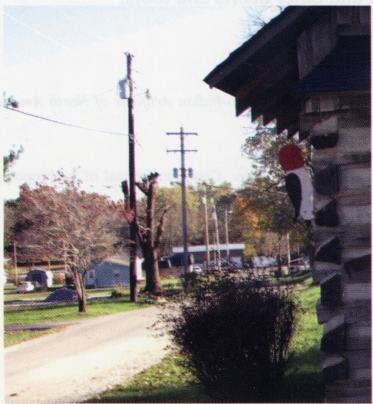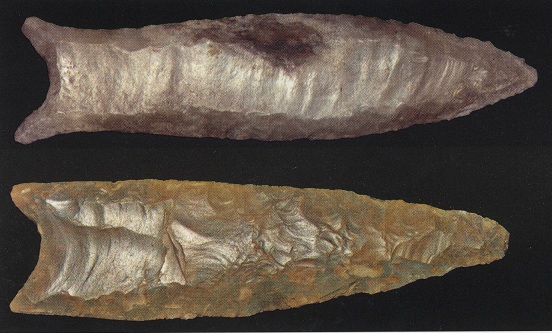by Steven R. Cooper, EIC
Originally Published in the Central States Archaeological Journal, Vol.55, No.1, pg.51
Since the dawn of time, man has tended to go for the “bigger is better” in nearly every activity. The King had to have the biggest castle. The White House was built to be the biggest house in the United States. Many times a collection is judged by how big it is, a show by how many tables and an event by a huge attendance.

Above: A street in Baxter, Tennessee, which is 63 miles from Nashville. Its population is just 1368 people compared to the over one million people who live in the greater Nashville area.
Recently I attended the Baxter Show. It is the longest running show in Tennessee. The word bigger doesn’t apply here in the normal sense. It is the smallest show in the state; held in an elementary school cafeteria with small tables at a height for youngsters to eat from. You could fit this entire show into a small corner of the big Collinsville Show. But sometimes big things come from small, and the Baxter Show is just such an event.
Prior to attending, I called the show hosts, Clarence Sewell and Dennis Burgess and mentioned my upcoming Paleo Issue. I welcomed any participation they might want to have. They said they would see what they could round up to share with me, and let some other collectors know too.

Pictured above are two points in the Bob Moyer collection. The four inch long Cumberland on the left was Bobs first find of the year in 1996. He found it on Salt Lick Creek in Jackson County. The interesting Clovis on the right was also found in Jackson County near the Dripping Rock Waterfall. This Clovis exhibits some interesting re-sharpening, and may have been picked up by a later culture and reused. The site it was found on is a multi-cultural site that has also yielded Motleys, Lost Lakes, Wheeler Recurvates and others.
I really wasn’t prepared for the feast I beheld when I arrived. I was viewing some of the most remarkable Paleo artifacts I have ever witnessed. I saw more fabulous pieces than I could imagine. I took many pictures and asked a lot of questions.
One of the most stunning pieces was a huge Delbert Style Clovis. All that was found was the base, but it was a whopping 4 Y2 inches. This point, were it all there, would of perhaps exceeded the size of the largest Clovis ever found (see page 3 for a pciture of the Rutz Clovis).

Above is the base of a Debert Style Clovis made from Ft. Payne chert in the Dennis Burgess collection. This huge Clovis measures a whopping 4 V2 inches in length. It appears that it snapped in the very final stage of manufacture when the maker was trying to chip something off. There are two quartz inclusions in the material, and possibly when striking a flake off one of them, the piece broke apart. It was found two feet below the surface next to what turned out to be a ten foot in diameter fire pit. Around this same fire pit Quad Points and Cumberland Points were also found, showing this particular place was utilized for an extensive period of time.
Then I was shown a group of points I had never seen before. The collector asked “What do you think these are?” Before I could answer, he said “Notched Lermas!” He then related how he had dug on a multicultural site than had been occupied for thousands of years. It had a Clovis level. But the deposits didn’t end there and he dug further. Below this Clovis level he found some Cumberland points and Lermas. He then stated that he felt Lerma’s were “Cumberland mans knife.”
We talked on and on for several hours. Then the show host, Clarence invited me to his home to see his largest find. While not prehistoric,it is the only surviving cabin from the pioneer period Fort Blount, built in 1794. He said the cabin was about to be demolished and burned back in the 1950’s, when he offered to buy it. He mentioned he paid just $25 for it. There is some evidence Andrew Jackson might have slept in it! Today, nothing further remains of the fort except postholes. It just goes to show that if you don’t preserve the past it will go away and be gone!
By the end of the day I had taken so many pictures I could probably print a book.
Baxter is a small town, just a few miles off of Interstate 40. You truly never know what you might be driving by when you pass an exit. But I can guarantee there are many surprises, and those little towns are much bigger than they appear.

Above is show host Clarence Sewell, next to the original Ft Blount cabin. He moved it piece by piece and reassembled it at its current location. Clarence has lived in the area all his life and is an expert on its history.

Above, shown full size, both sides of an exceptionally fine 4 1/2 inch long St. Louis Style Clovis. It was found in Jackson County, Tennessee in mud pushed up during dozer work. It has exceedingly fine flaking and long flutes. It is made of a Tennessee hornstone.
“Used by Permission of the Author”
To learn more about or to join the Central States Archaeological Society, click here:CSASI.org